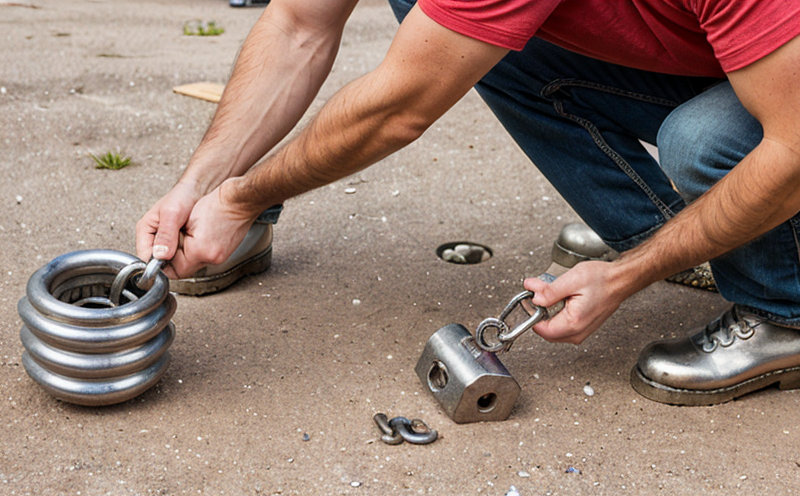Shackle inspection
In the realm of lifting equipment and cranes, shackles play a critical role in ensuring safety and reliability. Shackles are essential components that connect various parts of lifting gear, transferring loads from one point to another. Given their pivotal function, the integrity of shackles is paramount for preventing accidents and maintaining operational efficiency.
Shackles used in industrial settings must meet stringent standards such as ISO 4382:2016 or ASME PCC-1. These standards outline the acceptable dimensions, material properties, and testing procedures necessary to ensure the shackle can withstand the stresses it will encounter during use.
The inspection process for shackles is designed to identify any defects that could compromise their structural integrity. This includes checking for cracks, deformation, corrosion, or other signs of wear. The procedure typically involves visual inspection followed by more rigorous tests such as ultrasonic testing (UT), magnetic particle inspection (MPI), and liquid penetrant testing (LPT).
Visual inspections are the first line of defense, where trained technicians look for visible signs of damage on the surface of the shackle. However, these methods alone may not detect internal flaws that could pose a risk. Therefore, non-destructive testing techniques become essential:
- Ultrasonic Testing (UT): This method uses high-frequency sound waves to penetrate the shackle and detect any internal defects.
- Magnetic Particle Inspection (MPI): Suitable for ferromagnetic materials, MPI involves applying a magnetic field to the shackle and then dusting it with iron particles. Any cracks or flaws will create an attractive path for these particles, making them visible.
- Liquid Penetrant Testing (LPT): This technique is effective on non-porous surfaces. A dye penetrates any surface-breaking defects, allowing technicians to identify the location and size of the flaw once the excess liquid is removed.
The choice of testing method depends on the type of material used in the shackle and the nature of the expected defects. For instance, UT might be preferred for carbon steel shackles while MPI could be more appropriate for stainless steel components.
Once inspected, shackles are categorized based on their condition:
- New or like-new condition: Shackles that have passed all inspections without any defects.
- Repaired or repaired to specification: Shackles with minor defects but deemed repairable and safe for use after appropriate treatment.
- Condition-rejected: Shackles showing significant damage, such as cracks or excessive wear, which make them unsuitable for further service.
This categorization ensures that only fit-for-purpose shackles are used in critical lifting operations. Proper maintenance and inspection of shackles contribute significantly to the overall safety of lifting equipment and cranes, reducing the risk of accidents and downtime.
Industry Applications
The application of shackle inspection is widespread across various sectors where heavy lifting is required. In construction sites, for example, shackles are used in scaffolding, cranes, and hoists to secure loads safely during building operations. In the offshore industry, they play a crucial role in securing rig components and ensuring the safety of personnel working at sea.
In manufacturing facilities, shackles are indispensable in material handling equipment such as forklifts and conveyor systems. They ensure that materials are moved efficiently and safely within production environments. The aerospace sector also relies heavily on shackle inspection to maintain the integrity of lifting gear used during aircraft assembly and maintenance.
Shackles must comply with specific standards depending on their application:
- ISO 4382:2016 covers shackles for general industrial use, including those in construction and manufacturing.
- ASME PCC-1 addresses the design, fabrication, inspection, and testing of cranes and lifting appliances.
- EN 13478:2016 specifies requirements for shackles used in lifting equipment, particularly in offshore applications.
By adhering to these standards, industries can ensure that their lifting equipment remains safe and reliable, reducing the risk of accidents and ensuring compliance with international regulations.
Quality and Reliability Assurance
The quality assurance process for shackle inspection is rigorous and involves several critical steps:
- Initial Inspection: Shackles are visually inspected to check for any visible damage or defects.
- Material Testing: Samples are taken from the shackles to test their material properties, ensuring they meet the required standards.
- NDT Techniques: As mentioned earlier, UT, MPI, and LPT are used to detect internal and surface flaws.
- Load Tests: Shackles are subjected to simulated loading conditions to assess their strength and durability.
- Environmental Testing: Some shackles may undergo testing to ensure they can withstand specific environmental conditions such as temperature changes or corrosive atmospheres.
The results of these tests are meticulously recorded, providing a comprehensive report on the condition and fitness-for-purpose of each shackle. This documentation is crucial for maintaining compliance with industry standards and ensuring safety in lifting operations.
Regular inspections and maintenance schedules help extend the lifespan of shackles and reduce the risk of failure during use. By adhering to these quality assurance protocols, industries can ensure that their lifting equipment remains safe and reliable, contributing to a safer working environment for all personnel involved.
Environmental and Sustainability Contributions
The inspection and maintenance of shackles contribute significantly to environmental sustainability by preventing accidents that could lead to hazardous waste. By ensuring the integrity of lifting equipment, these inspections help prevent incidents such as spills or drops during material handling operations.
In addition, the use of non-destructive testing methods ensures that only necessary repairs are made, minimizing material wastage and promoting resource efficiency. The reconditioning of shackles allows for a longer lifespan, reducing the need for frequent replacements and lowering the overall carbon footprint associated with manufacturing new components.
Furthermore, compliance with international standards like ISO 4382:2016 and ASME PCC-1 ensures that lifting equipment is designed and maintained to the highest safety standards. This reduces the risk of accidents, which in turn minimizes the environmental impact caused by emergency situations such as spills or fires.
By prioritizing regular inspections and maintenance, industries can significantly contribute to a more sustainable approach to material handling and crane operations. The focus on quality and reliability not only enhances safety but also promotes responsible resource management and long-term sustainability in industrial applications.





